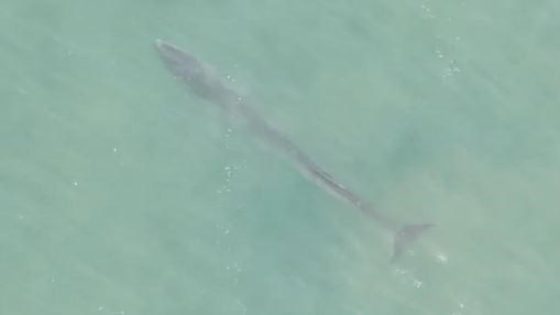A remarkable event occurred on February 18, 2025, when a common fin whale was spotted near a wind farm in the North Sea. This sighting marks the first confirmed live observation of a fin whale in Belgium, according to the Institute of Nature Sciences. Could this be a sign of changing marine life in our waters?
- Common fin whale sighted near wind farm
- First confirmed live sighting in Belgium
- C-Power employee spotted the whale
- Fin whales have extensive global habitat
- They migrate to colder and warmer waters
- Second largest whale species on Earth
The Rare Sighting of a Common Fin Whale Near Belgium
What does it mean when a common fin whale is spotted so close to shore? On February 18, 2025, C-Power staff observed this majestic creature several kilometers from the Belgian coastline. The Institute for Nature Sciences confirmed that this is the first documented live sighting of a fin whale in Belgium’s waters.
Understanding Fin Whales and Their Habitat
Common fin whales are known for their extensive range across all oceans worldwide. They migrate seasonally between warmer breeding grounds and colder feeding areas. Interestingly, while they typically avoid shallow waters like those found in the North Sea, they can occasionally be seen there during migrations.
- Fin whales can reach lengths up to 27 meters.
- This species is second only to blue whales in size.
- Their diet mainly consists of small fish and krill.
- Historically, most sightings in Belgium involved deceased whales washed ashore.
The Significance of Marine Life Observations
Why should we care about sightings like these? Observations help scientists understand marine biodiversity and ecosystem health. The presence or absence of certain species can indicate changes within their environment due to factors like pollution or climate change.
The Future of Marine Conservation Efforts
This extraordinary encounter serves as a reminder that ongoing conservation efforts are crucial. Protecting marine habitats not only benefits wildlife but also enhances our understanding of ecological balance. What steps can we take to ensure such magnificent creatures thrive?
The Role of Technology in Wildlife Monitoring
Modern technology plays an essential role in tracking marine life. Innovations like drones and underwater cameras allow researchers to monitor populations effectively without disturbing them. How might these advancements shape our approach to conservation?
This recent sighting not only captivates nature enthusiasts but also emphasizes the need for continued vigilance regarding our oceans’ health. Engaging with local conservation initiatives can make a difference—are you ready to get involved?










![[EN DIRECTE] Centenars de persones es concentren a la Casa Orsola per evitar el desnonament d’un veí](https://news.faharas.net/wp-content/uploads/2025/01/Massive-Crowd-Gathers-at-Casa-Orsola-to-Prevent-Neighbors-Eviction-560x315.jpg)
![[RECULL FOTOGRÀFIC] La dignitat i el coratge de les víctimes que demanen la dimissió de Mazón - VilaWeb](https://news.faharas.net/wp-content/uploads/2025/02/Unyielding-Courage-Victims-Demand-Mazons-Resignation-in-Powerful-Photo-Recap-560x315.jpeg)


















